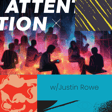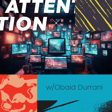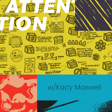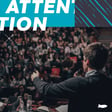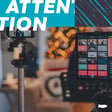Become a Creator today!Start creating today - Share your story with the world!
Start for free
00:00:00
00:00:01

Forget "Product-First". Become an Audience-First Company
In this episode, Dan Sanchez borrows an other concept from the startup world to uncover why audiences grow. He takes the popular company methodology of "product-first" and goes one step farther and applies the thinking to audience growth.
You'll learn about:
The pros and cons of being a "product-first" company
How starting a company with an audience-first mindset works better.
Practical steps to become more audience focused with your company
You'll learn about:
The pros and cons of being a "product-first" company
How starting a company with an audience-first mindset works better.
Practical steps to become more audience focused with your company
Transcript
Introduction to Audience-First Companies
00:00:04
Speaker
Welcome back to the Attention Podcast. I'm Dan Sanchez with Sweet Fish, and today we're going to be stealing yet another concept from the startup world to help us improve our audience growth. That is the product first company. And in this episode, I wanted to throw out the idea of an audience first company.
Product-First vs. Audience-First Strategies
00:00:22
Speaker
To start, let's quickly recap, though, what it means to be a product-first company. It's a reaction to the sales-driven company, which has been most companies throughout history, right? Every company wants to make money. Every company needs to have some revenue going. So they look to sales and they've looked to marketing, working together to drive new users, to drive new sales of new products, new acquisition.
Freemium SaaS and Product-First Success
00:00:48
Speaker
But the product-first company
00:00:50
Speaker
emphasized instead the product over the sale. Let's make the product so good, they said, that it will market itself. It optimizes for product usage and engagement.
00:01:02
Speaker
And it makes sense because if you're getting new sales all the time but people try your service or product or SaaS or whatever it is and try it and say, eh, it's okay. They're probably going to move on. They'll probably forget about you and they'll probably never buy again, even for just a C plus experience. So the product first movement has been fantastic because it says, let's make something
00:01:26
Speaker
remarkable. So that not only do we retain our users longer, making more money, but those users are more likely to become raving fans, sharing the product, making it so much easier to grow. Now naturally the freemium sass model has been the pioneer of this movement
00:01:46
Speaker
We think of a few examples like MailChimp who were early to adopt making it easy to send out an email newsletter and then putting in little delightful things in it that just made it fun to use. Because before, and I don't know if you can remember this, making an HTML email was a frickin' pain.
00:02:04
Speaker
MailChimp made it easy, and they made all kinds of little illustration and copywriting decisions in the product to just make it fun. So not only did it become hard, but it actually became easy and fun to use. And that was a big reason why MailChimp was able to grow.
Case Study: Western Governors University
00:02:21
Speaker
A less used option is a college by the name of Western Governors University. And the reason why I know about it was because I'm an alumni of the college.
00:02:31
Speaker
They spend hardly any money on marketing because all their marketing comes from the alumni, like I'm talking about it right now. And it's because they focused on building an awesome product. They focused on building something people would want to talk about. And the thing that WGU does better than anybody else is creating a competency-based program, which means essentially, if you know the material, you can essentially test through or quickly jump to the papers that you need to write in order to test out of every class.
00:02:59
Speaker
or not test out, but work your way out of every class. So a class could take a day, it could take a week, it could take two months if you don't know the material, allowing you to go as fast as possible. And the faster you go, the less it costs. I actually went through my whole bachelor's degree in eight months and only paid about 1400 bucks with some help from the Pell. But you hear things like that. And you're like, Oh, crap.
00:03:21
Speaker
I paid 50 grand. So when you share this with other people, all of a sudden the value proposition just starts to look really good, right? And that's a product driven model. It's a great thing.
Building Audience Relationships
00:03:31
Speaker
But today I want to explore a different concept. One we can take from this awesome model of being a product driven first company and question if there's maybe a better model
00:03:43
Speaker
I like to call an audience first company. Now I think there's room for both to play. I think you can have a product driven company and I think you can also have an audience
00:03:53
Speaker
driven company. Let's look at some of the comparisons I'll make in order to make the case. One thing I've noticed with product first companies is they tend to get out of the building a little bit too late. There's a lot of product first companies out there that we never hear about. We only hear the success stories of the drop boxes and the mail chimps, but there's a lot of product first companies that never make it.
00:04:16
Speaker
because they focused all in on the product and they never actually talked to the end user until it was too late. They invested too much of their time, their energy, potentially lots of VC funds. Or if they did get out there and finally got a little something going, they never talked to the audience enough. So they never really developed an intimacy
00:04:39
Speaker
and a really strong understanding of what their target audience, like what their life is like, what they think, what they feel, what keeps them up at night, what they wish could be, what they haven't even considered that would excite them because they don't spend enough time with the people.
Audience Understanding and Market Strategies
00:04:56
Speaker
Now an audience first company is focused primarily on the people because the whole goal is not to sell them something, but just to capture their attention. And the only way you're going to capture their attention is by having a deep understanding
00:05:10
Speaker
of what they think and what they feel and what they want out of life or is specifically in the little corner of life that you're trying to capture their attention in, maybe related to their career, maybe related to their job, maybe related to their finances, maybe related to their nutrition, whatever it is. You want to intimately understand how they think about that area of their life.
00:05:34
Speaker
With an audience-first company in building an audience before you even build the product, the go-to-market is actually remarkably faster, right? Because if you have an audience, you can build rapid feedback into testing your product because you have thousands of people, maybe more, tens of thousands, over 100,000 people who are willing to give you feedback on any product idea you come up with.
00:06:02
Speaker
and it's built in marketing. An audience focused company doesn't have to beg for attention from publications. The publications comes to you. There's a reason why you're attracting an audience. And if you're attracting a crowd, usually the media entities in the industry are curious to see what you've got going on. So one of the things I learned from Chris Walker this last year is he's growing an audience. He's forget PR what comes to you. If you have an owned media entity, if you have attention,
00:06:29
Speaker
The media will come to you and they will publish your story. Another thing is an audience first company only has to pay for advertising when the price is right because they don't depend on advertising. They're not addicted to Facebook ads or Google ads or whatever the paid media of the day is. They don't have to pay for it. They already have it. Now, I'm not saying paid media is bad. Paid media is fantastic. It's a great way to grow an audience.
00:06:56
Speaker
But you're not dependent on it if you already have your own audience. And I think my favorite part about an audience first company is that it's not dependent on the product.
Flexibility and Growth in Audience-First Companies
00:07:08
Speaker
What company can say that? What company can say, look, we don't need this product. We have this massive audience and we can just launch a new product. Not very many.
00:07:18
Speaker
But that is something that is more valuable than even a solid product going forward because if you have a lot of attention, you can come up with new products until you find one that really hits. It makes it so much easier to launch a product that it almost makes the product first focus look vulnerable.
00:07:40
Speaker
So two examples of an audience-first company is Sweetfish for starters, the company that I represent being a B2B podcast agency. A lot of our growth comes from our own podcast, B2B Growth, and hopefully soon this podcast.
00:07:57
Speaker
A lot of it comes from the audience that we've developed on LinkedIn and social media. If it weren't for those things, Sweetfish wouldn't have the product it does today. And honestly, if our agency went away, we would still have the audience to be able to market something to. We could come up with a SaaS product. We could come up with more resources.
00:08:15
Speaker
We have an audience in order to talk to and actually make things better and better or to launch new products to.
Case Study: Refined Labs with Chris Walker
00:08:21
Speaker
Another one that comes to mind and is talked about on LinkedIn all the time is Refined Labs. Chris Walker is a very strong personal brand with a massive audience. If Chris Walker launched a new product offering, I'm pretty sure it would go well. And if it didn't, he'd be able to iterate very quickly because of the feedback of his devoted audience.
Steps to Becoming Audience-First
00:08:41
Speaker
So how do you become a more audience-focused company?
00:08:44
Speaker
Here's three ideas to get started. First, if you want to be audience first, then it has to be a strategic priority. It has to come from the top. We have to have buy-in.
00:08:58
Speaker
from leadership in order to make this change because the whole company has to be around it in order for the company to be audience first. If you want to actually play and be like a media company yet come up with products like a product focus company, if you want to walk and talk like a media company then you need to have an orientation like a media company. Number two is you need to prioritize more of your marketing budget just to audience growth.
00:09:22
Speaker
just towards the content development, just towards promoting the audience channels, just towards conversion rate optimization to drive people down the funnel to becoming a subscriber. Yes, you need your own funnel just for your audience growth initiatives. And lastly,
00:09:39
Speaker
Become obsessed with your target audience. You need to be in constant conversations, both in-person conversations, or Zoom at least, and on social, having engaging conversations daily, hopefully, but even weekly would be better for some companies. That way you're always in tune with what the audience is thinking, what they're fearing, what's priority for them. And you can take those insights and turn it into better content
00:10:08
Speaker
and of course, use it to inform your products.
Listener Engagement and Feedback Request
00:10:12
Speaker
Thanks for listening. Since you've made it this far, I'd like to ask for one favor. If you could please just leave a rating for the show, whether it's on Apple or Spotify, which now has ratings, praise God, every single rating helps.






